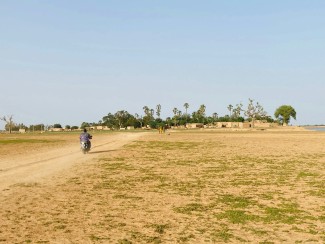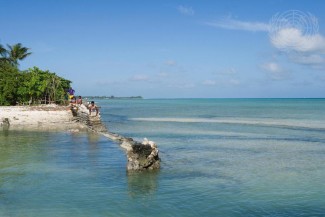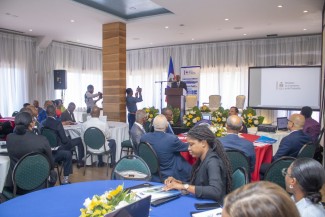In 2017, Bangladesh’s Ministry of Commerce secured US$50 million from the World Bank to address trade facilitation and export diversification issues. Key to that success was a comprehensive trade study that outlined priority actions for the country to take, and which received high-level endorsement.
The story begins in 2010, when the Government of Bangladesh asked the World Bank to provide technical assistance with trade issues. They agreed to conduct a macroeconomic analysis known as a Diagnostic Trade Integration Study (DTIS).
[related-article]
At the time, Bangladesh was struggling with a number of trade issues, including inadequate trade-related infrastructure, cumbersome paper-based procedures, and slow border crossings biasing the economy away from exports and eroding other competitive advantages.
“We hoped the DTIS would not only comprehensively analyse the trade challenges we were experiencing, but also offer a plan for how we could enhance trade,” said Md. Hafizur Rahman, Director General of the WTO cell at Bangladesh’s Ministry of Commerce.
Blueprint for trade
The study took place over four years, with time for consultations with stakeholders and culminating in the preparation of an ‘action matrix’ detailing proposed measures to address trade issues, expected results of each measure as well as possible implementation challenges.
“It was a huge study; it involved starting from the macro perspective of world trade to global value chains and the different sectors, and then overall investment climate issues, as well as the infrastructural issues starting from zones to warehousing… everything was touched upon,” said World Bank Private Sector Specialist Nusrat Nahid Babi, who began in the role as the DTIS was being launched.
Despite being broad, the DTIS process also helped the government of Bangladesh to focus its energies on a few key priorities, particularly with export diversification.
“For the past 20-30 years the government has been discussing export diversification and had about 36 sectors as priorities. You can’t really make meaningful progress on that many sectors at once. The DTIS cut that down to six sectors, and that really helped shape dialogue with the government,” Nahid Babi said.
However, Nahid Babi believes the process of preparing the DTIS was just as important as the outcomes of the study itself.
“During the four years that the DTIS was being prepared, we saw many government agencies address trade issues that were being brought to their attention. So, as well as being a blueprint for trade, the DTIS also helped shape the mindset for reforms to take place,” she said.
Commitment to implementation
Around the same time, Bangladesh was preparing its national five-year plan. Ensuring the DTIS’ strategic relevance with government priorities was key, Rahman said.
“When the DTIS was endorsed by the Prime Minister and the national five-year plan, all the other ministries, private organisations and development partners got the signal that there was serious commitment to implementation.”
The Prime Minister’s office also founded a DTIS implementation committee, tasked with turning the study’s findings into action.
“We contacted a number of development partners and donors to discuss our plan to implement the action matrix and, after several meetings, they indicated their interest in supporting a number of specific actions,” Rahman said.
The Ministry of Commerce then conducted a series of stakeholder meetings to begin the process of project design.
“We met with the National Board of Revenue, Single Window, Land Customs Authority, Land Port Authority, Bangladesh Standards and Testing Institute, the Livestock Department, the Department of Agricultural Extension, among others,” Rahman said.
During the four years that the DTIS was being prepared, we saw many government agencies address trade issues that were being brought to their attention. So, as well as being a blueprint for trade, the DTIS also helped shape the mindset for reforms to take place.
Nusrat Nahid Babi, World Bank Private Sector Specialist
In collaboration with the World Bank, they designed two projects. The first was a regional connectivity project to improve port infrastructure, implement an electronic customs system (national single window), establish a national trade and transport facilitation committee and better support women traders. The second was an export diversification project to build Bangladesh’s competitiveness in sectors other than ready-made garments (which account for over 90% of exports).
The fact that these project designs were based on rigorous evidence made it easier for them to obtain approval, Nahid Babi said.
“The fact that trade facilitation and export competitiveness were highlighted in the DTIS made it quite easy for us to pitch these projects to our internal management for approval.”
“The DTIS also helped to ensure that the commerce ministry had export diversification as a priority,” she added.
Allied act
Both projects began in 2017 and have since made significant progress.
“With the regional connectivity work, procurement has been completed to modernise one of the land ports, while the others are in the feasibility study/design stage,” Nahid Babi said.
When it comes to customs modernisation, the government signed an MoU with 39 government agencies and 6 key private sector associations, and finalised the technical and legal details for the National Single Window system and risk management software. This system is bringing 208 trade-related services under a common platform, and has been approved and enacted through Finance Bill 2020.
In addition, the National Board of Revenue (NBR) introduced reforms that benefitted 45,700 firms, resulting in the reduction of clearance times by approximately 9%.
The export diversification project has so far been focusing on high fashion garments, processed food and active pharmaceutical ingredients.
“We are planning to hire an international fashion designer to train in our fashion institutes and we have established a cooperation with a pharmaceutical producers association who will be training some of our experts to produce active pharmaceutical ingredients,” Rahman said.
So far, the DTIS has informed over US$1.18 billion worth of projects in Bangladesh, according to Nahid Babi.
“Many indirect projects have drawn heavily from the DTIS… when we have such a flagship publication, you will find many of the contemporary projects aligning to the findings of that report.”
“In customs they call it an ‘allied act’, well we would say that the DTIS is an ‘allied document’.”
Header image - ©REUTERS/Thierry Gouegnon
If you would like to reuse any material published here, please let us know by sending an email to EIF Communications: eifcommunications@wto.org.



